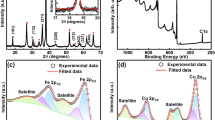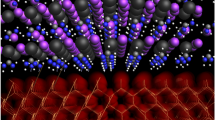Abstract
Cadmium sulfide (CdS) has been employed as an alternative acceptor for planar heterojunction solar cell based on copper phthalocyanine (CuPc). Spin-coated poly-3,4-ethylenedioxythiophene:polystyrenesulfonate (PEDOT:PSS) on indium tin oxide (ITO)-coated glass substrates was used for the vacuum deposition of CuPc and CdS planar heterojunction. In the present study, we have fabricated two different architectures of CuPc/CdS devices: (1) ITO/PEDOT:PSS/CuPc/CdS/Al and (2) ITO/PEDOT:PSS/CuPc/CdS/LiF/Al. Our results indicate that the CdS could effectively facilitate charge transport in the nanostructured network, and be a good acceptor. The fabricated bare CuPc/CdS device shows 0.13 % conversion efficiency while incorporation of LiF layer between CuPc/CdS and Al contact facilitates low-recombination rate results ~43 % enhancement in efficiency. The ITO/PEDOT:PSS/CuPc/CdS/LiF/Al device shows 0.30 % power conversion efficiency.










Similar content being viewed by others
References
Li G, Shrotriya V, Huang JS, Yao Y, Moriarty T, Emery K, Yang Y (2005) High-efficiency solution processable polymer photovoltaic cells by self-organization of polymer blends. Nat Mater 4:864–868
Sariciftci NS, Smilowitz L, Heeger AJ, Wudl F (1992) Photoinduced electron transfer from a conducting polymer to buckminsterfullerene. Science 258:1474–1476
Dou L, You J, Yang J, Chen CC, He Y, Murase S, Moriarty T, Emery K, Li G, Yang Y (2012) Tandem polymer solar cells featuring a spectrally matched low-bandgap polymer. Nat Photonics 6:180–185
Li G, Zhu R, Yang Y (2012) Polymer solar cells. Nat Photonics 6:153–161
Krebs FC (2008) Air stable polymer photovoltaics based on a process free from vacuum steps and fullerenes. Sol Energy Mater Sol Cells 92:715–726
White MS, Olson DC, Shaheen SE, Kopidakis N, Ginley DS (2009) Inverted bulk-heterojunction organic photovoltaic device using a solution-derived ZnO underlayer. Appl Phys Lett 89:143517–143519
Sonar P, Lim JPF, Chan KL (2011) Organic non-fullerene acceptors for organic photovoltaics. Energy Environ Sci 4:1558–1574
Mali SS, Dalavi DS, Bhosale PN, Betty CA, Chauhan AK, Patil PS (2012) Electro-optical properties of copper phthalocyanines (CuPc) vacuum deposited thin films. RSC Adv 2:2100–2104
Peumans P, Bulovic V, Forrest SR (2000) Efficient photon harvesting at high optical intensities in ultrathin organic double-heterostructure photovoltaic diodes. Appl Phys Lett 76:2650–2652
Yakimov A, Forrest SR (2002) High photovoltage multiple-heterojunction organic solar cells incorporating interfacial metallic nanoclusters. Appl Phys Lett 80:1667–1669
Xue J, Uchida S, Rand BP, Forrest SR (2004) 4.2 % efficient organic photovoltaic cells with low series resistances. Appl Phys Lett 84:3013–3015
Uchida S, Xue J, Rand BP, Forrest SR (2004) Organic small molecule solar cells with a homogeneously mixed copper phthalocyanine: C60 active layer. Appl Phys Lett 84:4218–4220
Arco LGD, Zhang Y, Schlenker CW, Ryu K, Thompson ME, Zhou C (2010) Continuous, highly flexible, and transparent graphene films by chemical vapor deposition for organic photovoltaics. ACS Nano 4:2865–2873
Pradhan B, Pal AJ (2004) Organic heterojunction photovoltaic cells: role of functional groups in electron acceptor materials. Sol Energy Mater Sol Cells 81:469–476
Sonar P, Ng GM, Lin TT, Dodabalapur A, Chen ZK (2010) Solution Processable Low band gap diketopyrrolopyrrole (DPP) based derivatives: novel acceptors for organic solar Cells. J Mater Chem 20:3626–3636
He Z, Zhao G, Han G (2006) Optical and photoelectric properties of copper phthalocyanine/cadmium sulphide multilayer films prepared by vacuum sublimation. Phys Status Solidi (a) 203:518–525
Smertenko PS, Kostylev VP, Kislyuk VV, Syngaevsky AF, Zynio SA, Dimitriev OP (2008) Photovoltaic cells based on cadmium sulphide–phthalocyanine heterojunction. Sol Energy Mater Sol Cells 92:976–979
Lee JC, Lee W, Han SH, Kim TG, Sung YM (2009) Synthesis of hybrid solar cells using CdS nanowire array grown on conductive glass substrates. Electrochem Commun 11:231–234
Greaney MJ, Das S, Webber DH, Bradforth SE, Brutchey RL (2012) Improving open circuit potential in hybrid P3HT:CdSe bulk heterojunction solar cells via colloidal tert-butylthiol ligand exchange. ACS Nano 6:4222–4230
Wang L, Zhao D, Su Z, Li B, Zhang Z, Shen D (2011) Enhanced efficiency of polymer/ZnO nanorods hybrid solar cell sensitized by CdS quantum dots. J Electrochem Soc 158:H804–H807
Brandenburg JE, Jin X, Kruszynska M, Ohland J, Kolny-Olesiak J, Riedel I, Borchert H, Parisi J (2011) Influence of particle size in hybrid solar cells composed of CdSe nanocrystals and poly(3-hexylthiophene). J Appl Phys 110:064509–064518
Liu X, Jiang Y, Lan X, Zhang Y, Liu C, Li J, Wang B, Yu Y, Wang W (2012) Improved efficiency of hybrid solar cell based on thiols-passivated CdS quantum dots and poly(3-hexythiophene). Phys Status Solidi A 209:1583–1587
Kang Y, Kim D (2006) Well-aligned CdS nanorod/conjugated polymer solar cells. Sol Energy Mater Sol Cells 90:166–174
Senthilarasu S, Sathyamoorthy R, Lee SH, Velumani S (2010) Characterization of zinc–phthalocyanine–CdS composite thin films for photovoltaic applications. Vacuum 84:1212–1215
Loutfy RO (1982) Photoconduction of phthalocyanines in the near-infrared. J Phys Chem 86:3302–3306
Edwards L, Gouterman M (1970) Porphyrins XV. Vapor absorption spectra and stability: phthalocyanines. J Mol Spectrosc 33:292–310
Tsidilkovsk IM (1982) Band structure of semiconductors. Pergamon Press, Oxford
Kamoun N, Bouzouita H, Rezig B (2007) Fabrication and characterization of Cu2ZnSnS4 thin films deposited by spray pyrolysis technique. Thin Solid Films 515:5949–5952
Mali SS, Kim HJ, Kim JH, Patil PS, Hong CK (2013) Synthesis and characterization of planar heterojunction hybrid polymer solar cells based on copper phthalocyanine (CuPc) and titanium dioxide. Ceram Int 40:643–649
Lozzi L, Ottaviano L, Santucci S (2002) Growth and electronic structure of CuFPc on Si(100). Surf Sci 507–510:351–356
van der Laan G, Westra C, Haas C, Sawatzky GA (1981) Satellite structure in photoelectron and Auger spectra of copper dihalides. Phys Rev B 23:4369–4380
Vanalakar SA, Mali SS, Pawar RC, Tarwal NL, Moholkar AV, Kim JA, Kwon YB, Kim JH, Patil PS (2011) Synthesis and characterization of Ru doped CuO thin films for supercapacitor based on Bronsted acidic ionic liquid. Electrochim Acta 56:2762–2768
Mali SS, Devan RS, Ma YR, Betty CA, Bhosale PN, Panmande RP, Kale BB, Jadkar SR, Patil PS (2012) Effective light harvesting in CdS nanoparticle-sensitized rutile TiO2 microspheres. Electrochim Acta 90:666–672
Shi SJ, Tu JP, Tang YY, Zhang YQ, Liu XY, Gu CD (2013) Enhanced electrochemical performance of LiF-modified LiNi1/3Co1/3Mn1/3O2 cathode materials for Li-ion batteries. J Power Sources 225:338–346
Mihailetchi VD, Blom PWM, Hummelen JC, Rispens MT (2003) Cathode dependence of the open-circuit voltage of polymer: fullerene bulk heterojunction solar cells. J Appl Phys 94:6849–6854
Sze SM (1992) Physics of semiconductor devices, vol 258. Wiley Sciences, New York, p 1474
Komolova AS, Møller PJ (2003) Photoconductivity and oxygen adsorption of Cu-phthalocyanine thin films on cadmium sulphide surfaces. Appl Surf Sci 212–213:497–500
Acknowledgements
This research was supported by the Basic Science Research Program through the National Research Foundation of Korea (NRF) funded by the Ministry of Education (NRF-2009-0094055).
Author information
Authors and Affiliations
Corresponding authors
Rights and permissions
About this article
Cite this article
Mali, S.S., Patil, P.S., Bhosale, P.N. et al. Novel hybrid solar cells based on α-copper phthalocyanine–cadmium sulfide planar heterojunction. J Mater Sci 49, 5100–5111 (2014). https://doi.org/10.1007/s10853-014-8218-z
Received:
Accepted:
Published:
Issue Date:
DOI: https://doi.org/10.1007/s10853-014-8218-z




